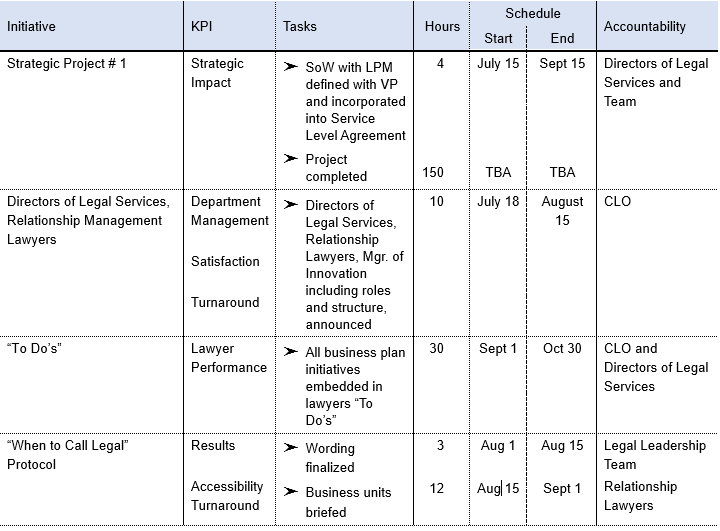
So much begins with planning by the law department, writes Richard Stock

Near the start of this millennium, a group of chief legal officers and general counsel convened to see if they could identify the elements of a successful law department. After two days, they agreed on 21 Critical Success Factors (CSF) and a number of indicators. I have often relied on their template when assessing the extent to which a law department has an integrated business strategy, aligned its resources, and how well it has performed.
So much begins with planning by the law department. The CSF for planning and its three indicators are basic, as discussed in an article last year.
CSF—The annual and long-range plans of the law department are closely aligned with corporate objectives.
Three indicators anchor this CSF:
Most law departments have written annual plans. But fewer than 20 percent have written long-range plans for the law department and only some of their objectives are closely aligned with corporate objectives. Planning assumptions are rarely documented and are not supported by multi-year forecasting of the demand for legal services expressed by type, volume, and complexity.
Even to this day, while law departments do complete corporate planning forms, they remain poorly aligned and reactive in deploying their resources. I rate the collective compliance with this CSF and the three indicators at only 5 out of 10.
Stanford University’s Robert Sutton co-wrote a book with Jeffrey Pfeffer called The Knowing – Doing Gap, based on case studies of companies he and his students prepared. Their overall findings were clear: the problem is not analysis – it is how to implement. They observed that some companies had a propensity for research and analysis rather than action, and that they needed to redo their values and vision. In highly competitive markets, new operating philosophies are needed which can be used to guide a wide range of actions in different situations.
They went on to identify five basic causes of the gap to implementation. Consensus building values in legal professionals make the first cause common. The Straight-Talk Trap favors waiting and planning in lieu of action. There are always one or two people in every group of 10 who fit this behaviour and who anchor 80 percent of the conversation. Their colleagues incorrectly let them forge ahead. The countermeasures include career and compensation systems which place greater value on action / results than on talk.
The other four causes of the Knowing-Doing Gap are:
What happens to the 20 percent of law departments that do have sound, robust and aligned business plans? One of the most valuable little books – because it is practical – that has influenced me in my consulting practice is Execution: The Discipline of Getting Things Done by Larry Bossidy and Ram Charan. Their thinking and advice is centered on people, strategy and operations. The introduction to the book is quite elegant:
ex-e-cu-tion (ek si kyoo shun), n.
1.The missing link.
2. The main reason companies fall short of their promises.
3. The gap between what a company's leaders want to achieve and the ability of their organizations to deliver it.
4. Not simply tactics, but a system of getting things done through questioning, analysis, and follow-through. A discipline for meshing strategy with reality, aligning people with goals, and achieving the results promised.
5. A central part of a company's strategy and its goals and the major job of any leader in business.
6. A discipline requiring a comprehensive understanding of a business, its people, and its environment.
7. The way to link the three core processes of any business the people process, the strategy, and the operating plan - together to get things done on time.
Still, there are success stories that defy the odds. Some law departments do have robust business plans and they do execute them. One CLO had thought about this a great deal and decided to commission what she called a “legal operations review” to ensure that the law department’s operations, activities, and resources were aligned with corporate strategy and that the value of the department was realized. The work order called for specific attention to making a more strategic contribution that added value to the organization, making the proper use of talent, identifying areas for efficiencies and delegation, and introducing law department best practices.
As is often the case, the review concluded that the law department could provide less reactive operational support to business units in the future. In-house counsel could be more available for activities which focus on prevention, coaching business units, and developing tools, templates, and skills for business units. Pivoting in this way depends on a new set of planning assumptions and new roles / responsibilities for law departments.
The review generated dozens of recommendations that were arranged in a balanced scorecard (dashboard) format. From this point implementation, not benchmarking, interviews and analysis became the true measure of success. The recommendations were converted into three groups of “initiatives”:
An effort was made to twin each initiative with a particular key performance indicator and then to estimate the number of law department hours required, set beginning and end dates, and assign one or more lawyers to be specifically accountable for each initiative.
Four examples follow.

There are, I believe, two ingredients that make this all work. The first is the commitment of the CLO / GC to the process and to measurable results. The second is a CLO / GC who is prepared to invest enough time for an entire business cycle to ensure implementation. I have had the pleasure of working with such individuals.